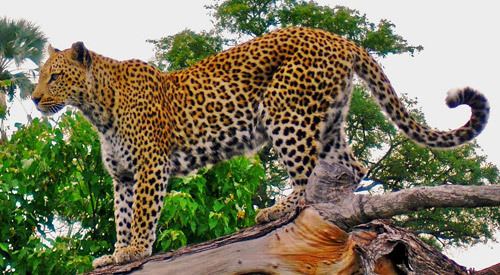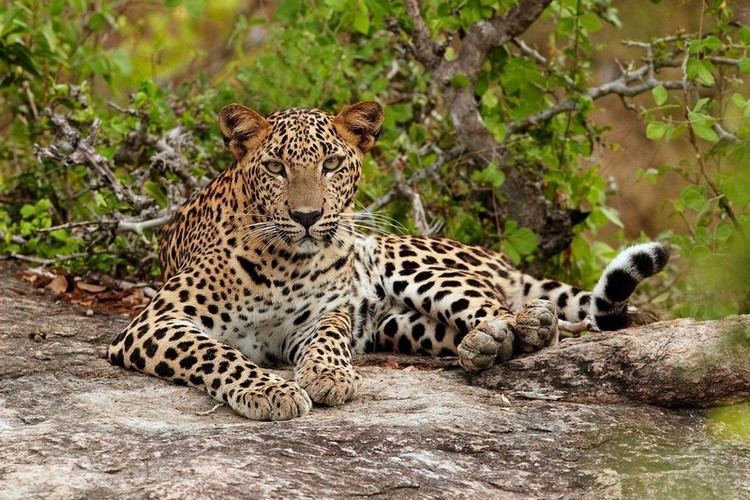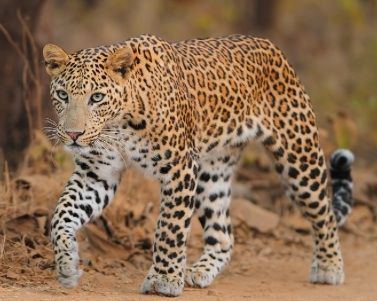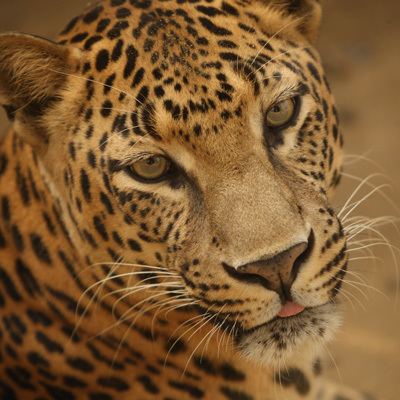Higher classification Leopard | Phylum Chordata Scientific name Panthera pardus fusca Rank Subspecies | |
 | ||
Mass Male: 50 – 77 kg, Female: 29 – 34 kg Size of territory Male: 48 km² (Home range, Bardia National Park population) Length Male: 1.3 – 1.4 m, Female: 1 – 1.2 m Similar Leopard, African leopard, Persian leopard, Felidae, Roaring cats | ||
Indian leopard (Panthera pardus fusca) is a leopard subspecies widely distributed on the Indian subcontinent. The species Panthera pardus is listed as Vulnerable on the IUCN Red List because populations have declined following habitat loss and fragmentation, poaching for the illegal trade of skins and body parts, and persecution due to conflict situations.
Contents
- Facts
- Animal rescue indian leopard rescued from 30 feet well wild
- Characteristics
- Distribution and habitat
- Population
- Ecology and behaviour
- Sympatric carnivores
- Threats
- Poaching
- Humanleopard conflict
- Man eaters
- Conservation
- In culture
- References

The Indian leopard is one of the big cats found on the Indian subcontinent, apart from the Asiatic lion, Bengal and Indochinese tigers, snow leopard and clouded leopard.

In 2014, a national census of leopards around tiger habitats was carried out in India except the northeast. 7,910 individuals were estimated in surveyed areas and a national total of 12,000-14,000 speculated.

Facts
Animal rescue indian leopard rescued from 30 feet well wild
Characteristics

In 1794, Friedrich Albrecht Anton Meyer wrote the first description of Felis fusca, in which he gave account of a panther-like cat from Bengal of about 85.5 cm (33.7 in), with strong legs and a long well-formed tail, head as big as a panther’s, broad muzzle, short ears and small, yellowish grey eyes, light grey ocular bulbs; black at first sight, but on closer examination dark brown with circular darker coloured spots, tinged pale red underneath. Male Indian leopards grow to between 4 ft 2 in (127 cm) and 4 ft 8 in (142 cm) in body size with a 2 ft 6 in (76 cm) to 3 ft (91 cm) long tail and weigh between 110 and 170 lb (50 and 77 kg). Females are smaller, growing to between 3 ft 5 in (104 cm) and 3 ft 10 in (117 cm) in body size with a 2 ft 6 in (76 cm) to 2 ft 10.5 in (87.6 cm) long tail, and weigh between 64 and 75 lb (29 and 34 kg). Sexually dimorphic, males are larger and heavier than females.

The coat is spotted and rosetted on pale yellow to yellowish brown or golden background, except for the melanistic forms; spots fade toward the white underbelly and the insides and lower parts of the legs. Rosettes are most prominent on the back, flanks and hindquarters. The pattern of the rosettes is unique to each individual. Juveniles have woolly fur, and appear dark due to the densely arranged spots. The white-tipped tail is 60–100 centimetres (24–39 in) long, white underneath, and displays rosettes except toward the end, where the spots form incomplete bands. The rosettes are larger in Asian populations and their yellow coat tends to be more pale and cream coloured in desert populations, more gray in colder climates, and of a darker golden hue in rainforest habitats.

The clouded leopard can be told apart by its diffuse "clouds" of spots compared to the smaller and distinct rosettes of the leopard, longer legs and thinner tail.
Distribution and habitat

On the Indian subcontinent, topographical barriers to the dispersal of this subspecies are the Indus River in the west, and the Himalayas in the north. In the east, the Ganges Delta and the lower course of the Brahmaputra River form natural barriers to the range of the Indochinese leopard. Indian leopard is distributed all over India, in Nepal, Bhutan and parts of Pakistan. Bangladesh has no viable leopard population but there are occasional sightings in the forests of Sylhet, Chittagong Hill Tracts and Cox's Bazar.
The Indian leopard inhabits tropical rain forests, dry deciduous forests, temperate forests and northern coniferous forests but does not occur in the mangrove forests of the Sundarbans.
Population
In 2015, 7,910 leopards were estimated to live in and around tiger habitat in India; about 12,000 to 14,000 leopards were speculated to live in the entire country. The following table gives the major leopard populations in the Indian states.
Ecology and behaviour
Leopards are elusive, solitary, and largely nocturnal. They are known for their ability in climbing, and have been observed resting on tree branches during the day, dragging their kills up trees and hanging them there, and descending from trees headfirst. They are powerful swimmers, although are not as disposed to swimming as some other big cats, such as the tiger. They are very agile, and can run at over 58 kilometres per hour (36 mph), leap over 6 m (20 ft) horizontally, and jump up to 3 m (9.8 ft) vertically. They produce a number of vocalizations, including grunts, roars, growls, meows, and purrs.
In Nepal's Bardia National Park, home ranges of male leopards comprised about 48 km2 (19 sq mi), and of females about 17 km2 (6.6 sq mi); female home ranges decreased to 5 to 7 km2 (1.9 to 2.7 sq mi) when they had young cubs.
Leopards are versatile, opportunistic hunters, and have a very broad diet. The diet of Indian leopards include axis deer, sambar deer, nilgai, wild pig, common langur, hare and peafowl.
Although they are smaller than most other members of the genus Panthera, they are able to take large prey due to their massive skulls and powerful jaw muscles.
Depending on the region, leopards may mate all year round. The estrous cycle lasts about 46 days and the female usually is in heat for 6–7 days. Gestation lasts for 90 to 105 days. Cubs are usually born in a litter of 2–4 cubs. Mortality of cubs is estimated at 41–50% during the first year. Females give birth in a cave, crevice among boulders, hollow tree, or thicket to make a den. Cubs are born with closed eyes, which open four to nine days after birth. The fur of the young tends to be longer and thicker than that of adults. Their pelage is also more gray in colour with less defined spots. Around three months of age, the young begin to follow the mother on hunts. At one year of age, leopard young can probably fend for themselves, but remain with the mother for 18–24 months. The average typical life span of a leopard is between 12 and 17 years.
Sympatric carnivores
Leopards share habitat with other predators. Indian leopards are not common in habitats where tiger density is high, and are wedged between prime tiger habitat on the one side, and cultivated village land on the other. Where the tiger population is high or increasing, tigers drive leopards off to areas located closer to human settlements, like in Nepal's Bardia National Park and in Rajasthan's Sariska Tiger Reserve.
In Gujarat's Gir National Park, the Indian leopard is sympatric with the Asiatic lion. This protected area is in the same ecoregion as Sariska Reserve, viz the Kathiawar-Gir dry deciduous forests.
In the Himalayas, it co-occurs with the snow leopard up to 5,200 m (17,100 ft) above sea level. They both hunt Himalayan tahr and musk deer, but the leopard usually prefers forested habitats located at lower altitudes than the snow leopard.
Elsewhere on the Indian subcontinent, the Indian leopard is sympatric with clouded leopard, jungle cat, leopard cat and fishing cat. It also shares habitat with golden jackal, Indian fox, striped hyena, dhole, Indian wolf, sloth bear and Asian black bear.
Threats
Hunting of Indian leopards for the illegal wildlife trade is the biggest threat to their survival. They are also threatened by loss of habitat and fragmentation of formerly connected populations, and various levels of human–leopard conflict in human–dominated landscapes.
Poaching
A significant immediate threat to wild leopard populations is the illegal trade in poached skins and body parts between India, Nepal and China. The governments of these countries have failed to implement adequate enforcement response, and wildlife crime remained a low priority in terms of political commitment and investment for years. There are well-organised gangs of professional poachers, who move from place to place and set up camp in vulnerable areas. Skins are rough-cured in the field and handed over to dealers, who send them for further treatment to Indian tanning centres. Buyers choose the skins from dealers or tanneries and smuggle them through a complex interlinking network to markets outside India, mainly in China. Seized skins in Kathmandu confirm the city's role as a key staging point for illegal skins smuggled from India bound for Tibet and China.
It is likely that seizures represent a tiny fraction of the total illegal trade, with the majority of smuggled skins reaching their intended end market. Seizures revealed:
In May 2010, the Wildlife Protection Society of India estimated that in India at least 3,189 leopards were killed since 1994. For every tiger skin, there are at least seven leopard skins in the haul.
Human–leopard conflict
Expansion of agriculturally used land, encroachment of humans and their livestock into protected areas are main factors contributing to habitat loss and decrease of wild prey. As a result, leopards approach human settlements, where they are tempted to prey on dogs, pigs and goats — domestic livestock, which constitutes an important part of their diet, if they live on the periphery of human habitations. Human–leopard conflict situations ensue, and have increased in recent years. In retaliation for attacks on livestock, leopards are shot, poisoned and trapped in snares. The leopards are considered to be unwanted trespassers by villagers. Conservationists criticize these actions, claiming that people are encroaching on the leopard's native habitat. India's Forest Department is entitled to set up traps only in cases of a leopard having attacked humans. If only the presence of a crowd of people prevents the leopard from escaping, then the crowd has to be dispersed and the animal allowed to escape.
As urban areas expanded, the natural habitats of leopards shrunk resulting in leopards venturing into urbanized areas due to easy access of domestic food sources. Karnataka has a high number of such conflicts. In recent years, leopards were sighted in Bangalore, and the forest department captured six leopards in the city's outskirts, relocated four of them to various other locations.
Man-eaters
The frequency of Leopard attacks on humans varies by geographical region and historical period. Attacks are regularly reported only in India and Nepal. Among the five "big cats", leopards are less likely to become man-eaters—only jaguars and snow leopards have a less fearsome reputation. However, leopards are established predators of non-human primates, sometimes preying on species as large as the western lowland gorilla. Other primates may make up 80% of the leopard's diet. While leopards generally avoid humans, they tolerate proximity to humans better than lions and tigers and often come into conflict with humans when raiding livestock.
Leopard attacks may have peaked in India during the late nineteenth and early twentieth centuries, coinciding with rapid urbanization. Attacks in India are still relatively common, and in some regions of the country leopards kill more humans than all other large carnivores combined. The Indian states of Gujarat, Himachal Pradesh, Maharashtra, Uttarakhand, and West Bengal experience the most severe human–leopard conflict.
In Nepal, the rate of leopard predation on humans is estimated to be 16 times higher than anywhere else, resulting in approximately 1.9 human deaths annually per million inhabitants. Most attacks occur in the midland regions, i.e. in the Terai, midhills, and lesser Himalaya.
It is possible for humans to win a fight with a leopard, as in the case of a 56-year-old woman who killed an attacking leopard with a sickle and spade, and survived with heavy injuries. Globally, attacks on humans—especially nonfatal attacks that result in only minor injury—likely remain under-reported due to the lack of monitoring programs and standardized reporting protocol. Notable man-eaters include Leopard of Panar, Leopard of the Central Provinces, Leopard of Rudraprayag, Leopard of Gummalapur, Leopard of the Yellagiri Hills and Leopard of the Golis Range.
Conservation
Panthera pardus is listed in CITES Appendix I. Despite India and Nepal being contracting parties to CITES, national legislation of both countries does not incorporate and address the spirit and concerns of CITES. Trained human resources, basic facilities and effective networks for control of poaching and trade in wildlife are lacking. Frederick Walter Champion was one of the first in India who after World War I advocated for the conservation of leopards, condemned sport hunting and recognised their key role in the ecosystem. Billy Arjan Singh championed their cause since the early 1970s.
In culture
A black Indian leopard named Bagheera is featured in The Jungle Book and also in The Jungle Book (1967 film) and The Jungle Book (2016 film).
